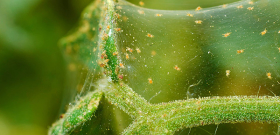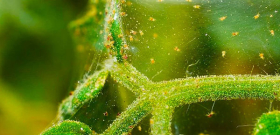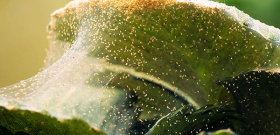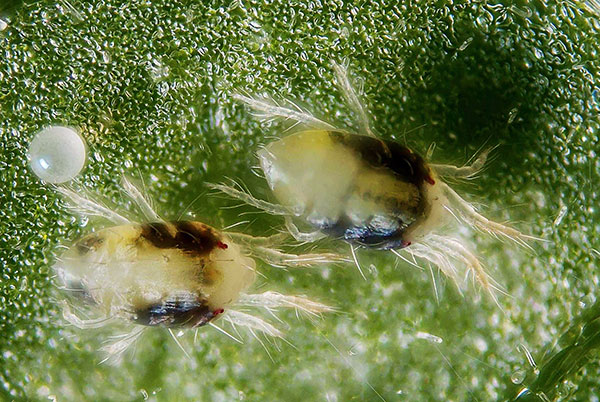
The spider mite is a widespread, quite versatile and very prolific pest of garden and indoor plants. Few gardens in the southern and middle strip of Eurasia have not been infected with a single tree or shrub, and few experienced gardeners have not experienced the invasion of these arthropods at least once in their practice. And those who have come across them know how dangerous spider mites are: if they are seriously affected, a tree or bush may not bear fruit at all, and in dry weather and poor watering, the plant may even die.
For example, the photo below shows an apple tree heavily infested with spider mites:

And here is a home orchid, also attacked by these pests:
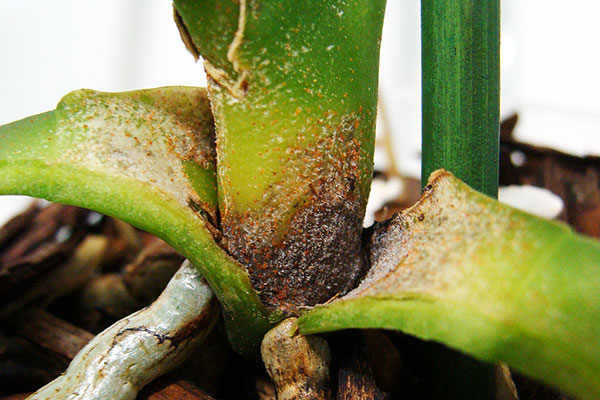
At the same time, the spider mite is not as well known as, for example, various insects, especially fruit pests. Normally, its activity does not particularly affect the quality of the fruit, and at least many gardeners do not notice a direct connection between its settlement on the plant and a decrease in yield. This is facilitated by the small size of the pest and the fact that at the stages, while the population is hardly noticeable, the harm from it does not particularly attract attention.
At the same time, it is relatively easy to fight the spider mite, it is sensitive to many common acaricides, and if detected and taken in time, it is quickly eliminated, and often the plant after its invasion is easy to cure.
Fundamentals of spider mite biology
The spider mite is a representative of the order of trombidiform mites of the arachnid class. This is one of many types of ticks that feed on plant foods and organic debris. It is very distantly related to ixodid ticks - parasites of humans and domestic animals that carry, for example, tick-borne encephalitis and Lyme disease.

Ixodid ticks parasitize humans or animals, while spider mites, feeding on plant sap, are not dangerous to humans.
On a note
Historically, it so happened that people are more familiar with parasitic mites - ixodid, scabies, glanders. And the information that many types of ticks feed on plant foods may be new to some. Nevertheless, both in terms of the number of species and mass character, herbivorous mites are many times superior to parasites and predators. Just because most people do not encounter them and do not know about them, there is a widespread belief that ticks are parasites.
In everyday life and practice in agriculture, the term "spider mite" is most often understood as any species of the family of spider mites, or tetranychids (from the Latin name of the taxon Tetranychidae). In total, scientists around the world count about 1200 species from this family, and due to disagreements in taxonomy, the exact number has not yet been established (many species are sometimes considered as separate subspecies, and vice versa).
The main distinguishing feature of the biology of spider mites, for which they got their name, is that adult females braid the affected plant with a small web, the individual fibers of which are not striking, but which in large quantities becomes quite noticeable on the surface of leaves and shoots.
The most common member of this family in Russia and Eurasia is the common spider mite (Tetranychus urticae). It is also the most malicious pest of plants in the open field of the whole family, but it also very often affects indoor flowers.
The photo below shows what this pest looks like:
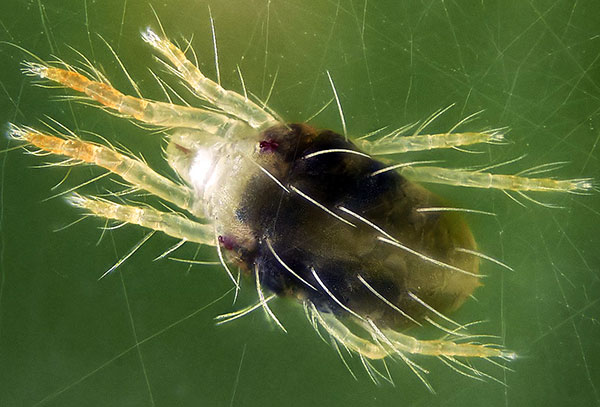
The common spider mite is common on all continents, but in many countries it is much less common than other members of this family.
In Eurasia, the following species are less common:
- Red spider mite (Tetranychus cinnabarinus) - it often infects indoor plants, although it is quite picky in the choice of food;
- Atlantic spider mite (Tetranychus atlanticus) - a malicious pest of cucumbers and some other melons, is ubiquitous;
- The Turkestan cotton spider mite (Tetranychus turkestani) is a widespread pest of horticultural crops, often infecting seedlings and adult plants of cucumbers, tomatoes, eggplants, and bell peppers. In the original habitats, it shows the greatest harmfulness on cotton;
- The red-legged spider mite (Tetranychus ludeni) is mostly a greenhouse and domestic pest, although it is often found on open ground plants.
All these species are distinguished by considerable nutritional versatility: spider mites can equally successfully infect trees, shrubs, and flowers, and they actively reproduce on all crops.
There are, however, in their food preferences and restrictions. For example, spider mites are not found on plants of the Gesneriaceae family; they very rarely infect succulents and ferns.

Kaleria (a flower of the Gesneriaceae family) is practically not subject to attack by spider mites.
On these plants, they are replaced by no less dangerous pests - flat mites, or simply flat mites (they are also called false spider mites). Both they themselves and the damage they cause are outwardly difficult to distinguish from spider mites and the consequences of their activity, but they have a characteristic difference - they do not leave cobwebs on plants.
Also, brown mites, or bryobia, cyclamen mites, wide and some others are similar to spider mites. In practice, it is not necessary to try to accurately determine whether a detected pest belongs to spider mites or to a related family - the principles of dealing with these pests are similar.
What does this pest look like?
Spider mites have a fairly recognizable body shape when viewed under a microscope. Below is a photo with an adult individual of an ordinary spider mite:

A dense red-brown body, translucent legs and pubescence throughout the body are clearly visible. In the front part of the body there is a gnathosoma with two chelicerae - they are the piercing-type oral apparatus, with which the mite pierces the walls of leaf cells in order to get to food.
The coloration of adult spider mites can vary considerably within the same species.So, adult individuals of an ordinary tick can be light yellow, brown, red, dark brown. The color of their bodies is influenced not only by the host plant, but also by the season of development of a particular generation.
For example, individuals of the common spider mite that hatch and develop in spring and summer are usually light brown or yellow in color. Females leaving for the winter are often red or dark brown.
Larvae and nymphs of spider mites are usually light yellow in color.
It is noteworthy that the larvae - the first stage emerging from the eggs - have 6 legs, while the nymphs already after the first molt and adult ticks have 8 legs.
However, without a microscope, all these details, up to the color of the body, are problematic to discern. The fact is that the size of these pests is very small: an adult female has a body length of up to 0.43 mm, an adult male - 0.25 mm. At the same time, all individuals during feeding try to keep at some distance from each other so as not to compete for food cells on the shoot of the plant, and therefore do not create clusters. Because of this, it is quite difficult to notice them with the naked eye.
For example, the photo below shows what a cucumber leaf looks like with spider mites on its surface at an early stage of infection:

As a rule, pests are not noticed at this stage, and they continue to multiply safely. Each female leaves several cobwebs on the lower surface of the leaf, and after a change of several generations on one plant, the most affected leaves, and sometimes entire shoots, are covered with a clearly visible continuous cobweb.
This is how, for example, a branch of an apple tree looks like with a strong reproduction of a spider mite on it:

The smallest dots are clearly visible - these are ticks of different ages.
At a certain period, there are a lot of parasites on the plant, and they can be seen even without a web. In autumn, females begin to descend from plants into the soil and can accumulate on branches and at their base where there is no cobweb. Here they look like an orange or reddish coating on the plant.
Different types of spider mites differ from each other in color elements, body shape and size. However, these differences are hardly noticeable without a microscope, and therefore it will not be possible to identify a specific species with the naked eye.
Life cycle
Spider mites are arthropods with a short life cycle and rapid generational change. The development cycle of an individual from the egg stage to maturity takes, depending on the air temperature, from 8 to 20 days, adult breeding mites live for about 20 more days.
In its development, each individual goes through 4 stages:
- Egg - develops 3-4 days;
- Larva - develops for 3-5 days and molts after full saturation into a nymph;
- Nymph - develops 6-12 days and molts;
- Imago, or adult, capable of reproduction.
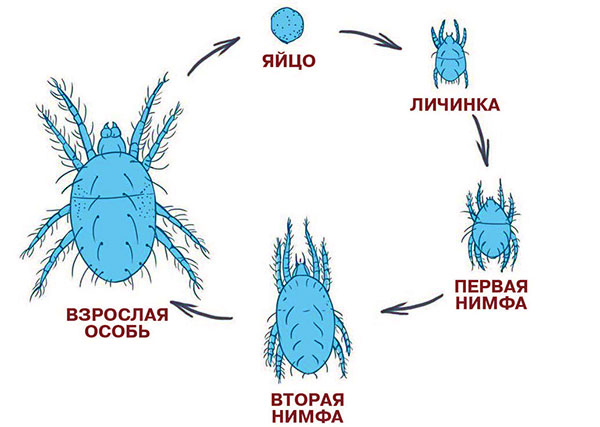
Life cycle of a spider mite.
In each colony there are individuals at different stages of development, as well as a large number of eggs.
The start of the colony is given by one or several females that have overwintered on the soil among plant debris. When the air temperature rises to 12-13°C, they leave their winter shelters, climb the nearest plants and begin to feed. Here, on plants, they leave a web and lay eggs.
With an abundance of food and in very hot weather, females can lay, among other things, unfertilized eggs, from which only males hatch.The fertilized eggs hatch into both females and males. In total, one female can lay up to 130 eggs in her life.
Hot dry weather promotes the rapid reproduction of spider mites. In the south of Russia, in the countries of Central Asia, in Ukraine and the Mediterranean, tetranychids can give up to 16-18 generations per year, and in greenhouses and in countries with mild winters, where the temperature does not drop below 12 ° C, pests do not leave for wintering and give up to 20-22 generations per year.
It is interesting
The fertility of spider mites is colossal and is constrained to the greatest extent by natural factors. It has been calculated that if 50 individuals survived from the offspring of each female, then in a year a single “tick” would develop 6 * 10 ^ 35 (6 with 35 zeros) offspring. They would cover the entire globe with a continuous layer 2.5 meters thick. Under natural conditions, most of the individuals are eaten by predators and die from other factors.
Individuals of summer generations are usually light in color, from yellow to light brown.
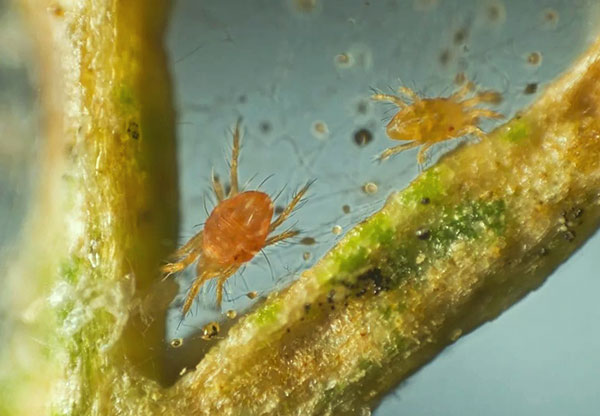
Spider mites that hatched in the summer are light in color.
Females of the latest generation darken in anticipation of cold weather, become dark red and descend from the host plant to the ground. Here they hide among fallen leaves, between clods of earth, among the roots of plants and fall into suspended animation. In this state, they overwinter, and in the spring they give rise to a new generation.
Features of nutrition and lifestyle
The spider mite is extremely polyphagous and is able to feed on a huge number of plants - from herbaceous to woody. Therefore, it is considered an even more dangerous pest than many insects, although capable of reproducing in large numbers, but feeding on fewer crops.
In fact, what a particular population will eat depends on which plant the female will climb out of her winter shelter. In some cases, ticks can be carried by the wind (they are even carried into apartments) with detached leaves, cobwebs or on their own, and when plants are intertwined, they can move from one to another. It is by moving from weeds growing in vegetable gardens, orchards and flower beds that they most often infect valuable plants.
To a certain extent, ticks travel from continent to continent with exotic plants that people transport for acclimatization or home cultivation.
Spider mites always live in any garden or garden, but they multiply en masse and harm relatively rarely, only under a combination of favorable conditions. Therefore, sometimes it may seem that there were no ticks, and then they abruptly come from somewhere. In fact, ticks do not start on the site, but are constantly present here, but usually they simply do not pay attention to themselves.
In apartments and houses, on the contrary, ticks appear by chance, most often with infected plants. Due to the presence of favorable conditions, they actively begin to multiply here, and almost certainly after such a settlement they will lead to an outbreak and the defeat of all plants.
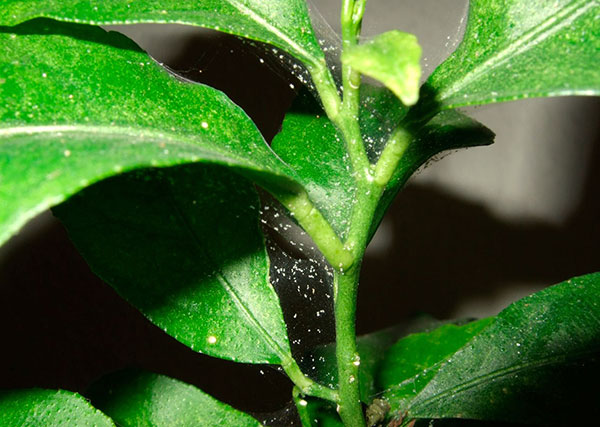
Most often, on indoor plants, spider mites appear due to a newly acquired plant that has already been affected by the parasite.
Directly on the plant, mites suck the contents of the cells of the leaves, young shoots and fruits. The pest pierces the cell wall with its stylet, inserts the gnathosoma into the hole, and begins to suck the liquid. After sucking out the contents of the entire cell, the tick moves to the next one.
On parts of plants covered with hard bark, spider mites cannot feed. Sometimes clusters of them are found here, but they usually arise due to the migration of females when leaving for the winter.
The optimal conditions for the development and reproduction of spider mites are air temperature in the range of 29-31 ° C and relative humidity 35-55%. The minimum temperature at which embryos develop in eggs, and females lay these eggs, is 12-14 ° C, depending on the region.
Females of summer generations die already at temperatures close to 0°C, and wintering individuals can tolerate frosts down to -28°C. The area of distribution of these pests from the north is limited to areas where in winter the temperature on the surface of the earth drops below the specified mark.
Damage caused by spider mites to plants
The spider mite is very dangerous for plants in that it leads to the oppression of infected bushes. Because of this, many undesirable consequences develop:
- The bushes weaken, individual shoots may die off, in dry times the entire affected plant may die;
- The appearance of infected plants deteriorates: brown or marble spots appear on their leaves, over time the leaves dry out and curl up, torn holes form in them. When fruits (for example, citrus fruits), as well as ornamental plants, are affected, they completely lose their presentation;
- The yield of infected plants is reduced. Even if a bush or tree survives, then unripe fruits are showered from many strongly ticked shoots;
- In affected plants, winter hardiness decreases; if they are not cared for, many die in severe frosts.
The photo below shows a leaf of an apple tree at the stage of infection, when its death has already begun, but there is still a little bit of cobweb and it is concentrated on the underside of the leaf:
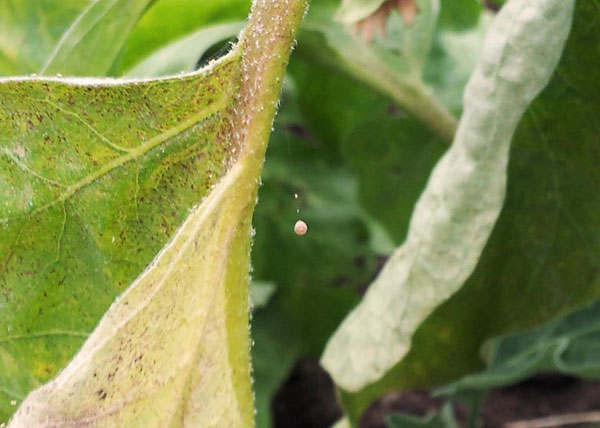
And this is already the terminal stage of infection, when the leaves and tops of the branches are completely covered with cobwebs:

A similar infection can occur with a wide variety of plant species. Spider mites are extremely polyphagous and harm almost any plant that a female capable of reproducing comes into contact with.
So, most often they are affected:
- Fruit bushes - raspberries, gooseberries, currants (moreover, the mite infects the black currant more often than red, white or California);
- Herbaceous fruit and vegetable crops - strawberries, blueberries, cucumbers, garlic, tomatoes, watermelons;
- Fruit trees - apple, pear, plum, quince, cherry and sweet cherry;
- Citrus fruits, both indoors and outdoors - lemons, oranges, tangerines;
- Ornamental deciduous plants, both herbaceous and shrubs and trees - marigolds (calendula), ficuses (including Benjamin's ficus, microcarp), balsam, hydrangea, gardenia, petunia, dracaena, sheflera, gerbera, geranium, chrysanthemums and navels, brugmansia , calatheas, balsam, spathiphyllum, anthurium, palergonium, boxwood, croton and others;
- Ephedra, especially with soft needles - arborvitae, blue spruce, fir, to a lesser extent ticks like junipers and pines;
- Various types of weeds. They, as a rule, are reservoirs of mites in the garden and in the garden.
Relatively weakly spider mites infect succulents - agaves, yuccas, cacti, aloe - and ferns.On these plants, they are usually replaced by flat mites, which are often mistaken for tetranychids, but which differ from them in structural features and in that they do not form cobwebs.

Microscopic photograph of a flatworm mite.
Finally, spider mites generally do not settle on saintpaulias (domestic violets with thick, hairy leaves) and plants of the Gesneriaceae family in general. These plants are also harmed by flat mites.
On a note
Due to the fact that most lovers of indoor plants do not distinguish between tetranychids and flat mites, there is an opinion that the spider mite actively infects the uzambar violets. There are many reports of such infections both on specialized forums and in quite authoritative literary sources. However, special studies have shown that in all cases only flat mites settle on Gesneriaceae, and tetranychids have never been found here.
The defeat of spider mites on the plant does not become noticeable immediately. When mites first begin to feed on it, there are few of them, and the damage they cause is small and scattered, so they are usually not paid attention to. The infection develops according to the following scenario:
- On the undersides of the leaves, white dots, almost invisible to the naked eye, appear in the places of the cells, from which the mites suck the juice. These points can be seen when looking at a leaf in the light of the sun;
- Over time, in places of accumulation of such points, brown or gray spots appear, constantly increasing in size. A marble color is formed at the leaf;
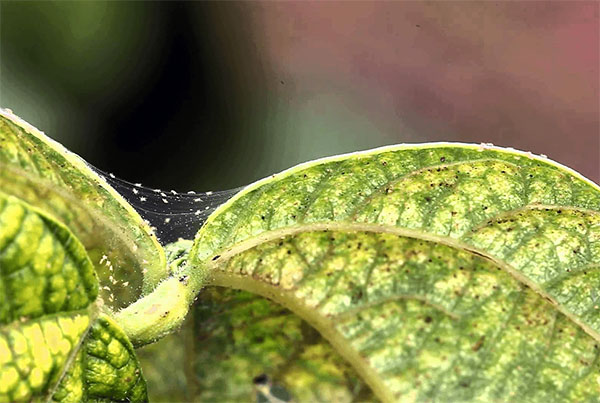
The leaves affected by the spider mite acquire a marble color.
- On the lower sides of the leaves, a white web becomes noticeable, gradually moving to the petiole and to the upper side of the leaf. First, mites become noticeable in the web itself, and then on the leaves under it. Usually pests attract attention at this stage;
- Severely affected leaves, and then the shoots dry up.
Ticking rarely leads to the complete death of the plant. More often, a plant weakened by pests dies either from a lack of moisture in a very dry time, or during severe frosts. Since the tick colony itself develops at about the same rate as its forage bush grows, even infection of seedlings usually does not lead to its death - when there are a lot of ticks, the bush also becomes quite strong.
On a note
For humans, spider mites are completely harmless. They cannot bite through skin, cannot suck blood, and cannot live anywhere but on the surface of plants. The notion that it is African spider mites that carry the dangerous South African fever is speculation: its pathogens, in fact, are carried by ixodid ticks. Therefore, bushes affected by tatranichids can be safely taken with your hands and carried out with them the manipulations necessary for the destruction of pests.
Means and methods of struggle
The fight against spider mites is carried out by several methods, differing in the speed of destruction of pests, efficiency and economy.
The main and most widely used method is the spraying of infected plants with acaricidal preparations. There are many such drugs, the most famous of which are the following:
- Means of the organophosphorus group - Fufanon (aka Karbofos and Malathion), preparations based on chlorpyrifos, Actellik, Metaphos, Phosphamide. They have a nerve-paralytic effect on ticks, while they are of little danger to humans and warm-blooded animals. Relatively inexpensive and fairly commercially available;
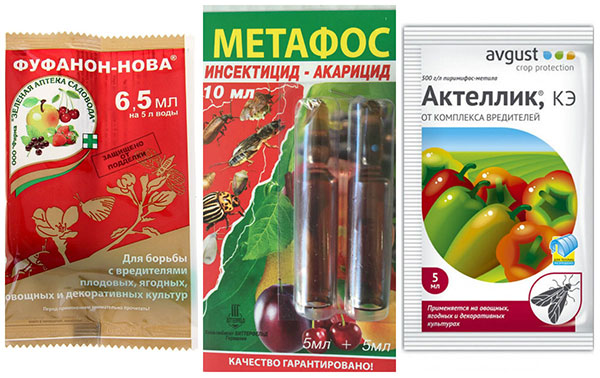
Drugs that have a nerve-paralytic effect on spider mites.
- Preparations based on acaricides of the avermectin group - Aktofit, Fitoverm, Vertimek. They are highly effective due to the fact that they penetrate into plant tissues and into the contents of cells, and with it into the intestines of feeding mites. Due to this, all individuals sucking plant sap are almost guaranteed to be affected;
- Pesticides with active ingredients of the neonicotinoid group - Commander, Imidor, Warrant;
- Funds based on substances of hormonal action - Apollo, Flumite and others. Sterilize female ticks and interrupt their reproduction, effective against spring and summer generations of ticks;
- Specific inhibitors of lipid synthesis - Movento, Oberon, Judo. Individuals affected by them stop growing and developing, which leads to the sterilization of adult females and the inability of nymphs to molt. Thus, the reproductive cycle of parasites is disrupted and they die out as the individuals already present on the plant die;
- Pyrethroid-based pesticides - Lightning, Vega, Shaman.
For the most pronounced effect, it is recommended to combine and alternate means from different groups - this ensures that those stages and individuals that may not be affected by one of the drugs used will be destroyed.
On a note
The most effective use of these funds is in early spring, when overwintered females rise to the plants, but many of their descendants have not yet appeared. The destruction of these females prevents further avalanche-like reproduction of the colony.
In rural and greenhouse farms of sufficient scale, special predatory mites are widely used - phytoseiulus, neoseiulus, halendromus. They feed exclusively on spider mites and multiply very quickly, destroying pests without any effect on plants and people. However, the acquisition of even a minimal batch of such mites is quite troublesome and costly, therefore it is rational only for large farms.
The photo below shows a Phytoseiulus eating an adult spider mite:
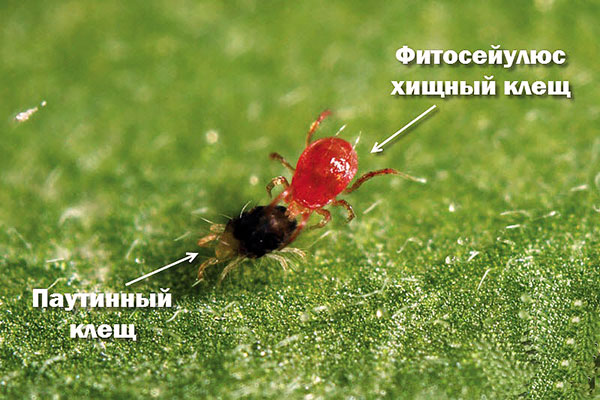
In household and household plots, various folk remedies for the destruction of spider mites are often used - alcohol, a decoction of garlic or onion peel, a soap solution, a decoction of cyclamen tubers, and even Fairy and some other dishwashing detergents, derivatives of folk remedies (for example, Extraflor based on an extract garlic). However, their effectiveness is largely limited, and pests can be successfully removed with their help only with repeated treatments on a small number of plants.
There are also recommendations for freezing ticks, when indoor plants are taken outside for a short time in the cold. This method seems to be very controversial. On the one hand, non-wintering ticks really die in the cold, on the other hand, this does not happen instantly, but during the time that they die, the plant itself can be severely damaged by frost.
In gardens and orchards, agrotechnical measures aimed at the destruction of wintering females are also very important. First of all, for this, fallen foxes are collected and burned, severely affected shoots are cut off, before the first frosts, trunk circles near bushes and trees are loosened, they dig up the ground between rows, and weeds are destroyed.
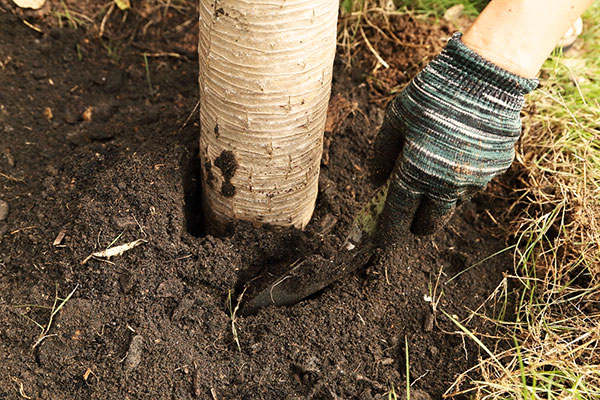
One of the methods of dealing with spider mites in the garden can be the autumn loosening of tree trunks.
Practice shows that at home, spider mites can be completely removed from an apartment or house, but this cannot be done in a garden or garden. Here the main task is simply to prevent them from multiplying in such quantities that they can pose a danger to plants.
After removing spider mites from the plants themselves, completely dead leaves, as well as buds, flowers, ovaries and fruits, should be removed. Then the bushes are watered abundantly, fertilizers are applied under them (preferably based on humus or manure), stimulating the formation of green mass. Any additional treatment for the affected plant is not required: if it still has green leaves, then it will recover.
In most cases, the plant can be saved if the mites themselves are killed in time. Some particularly delicate plants (such as orchids) need to be treated with special stimulant preparations.
Prevention of infection of plants with spider mites
There are no absolutely reliable measures to protect plants from spider mites. The pest can always be brought into the garden, greenhouse or garden with the wind, with leaves and just be here in the soil.Normally, outbreaks of its numbers are effectively suppressed by predators, which prevent ticks from breeding in large numbers, but if conditions in a particular year are favorable for pests, they multiply faster than predators destroy them.
Moreover, there is always a risk that the tick will be introduced even into an apartment or a greenhouse with new plants, in the soil under which there are wintering females, or on the leaves of which the summer generation of pests is already actively breeding.
Sufficiently reliable protection of plants in a garden or garden is provided by the agrotechnical measures already mentioned, to which you can add the removal of old dry bark from fruit trees in the fall - wintering females can also be under it.
All new plants that are planted in the garden or brought into a house or greenhouse should be thoroughly inspected and, ideally, quarantined. As part of such quarantine, they should be in a warm room with an air temperature of at least 20 ° C or in a fenced garden area for at least 2-3 weeks. After this period, they must be carefully examined with a magnifying glass and a microscope. During this time, sleeping female ticks should climb the leaves and begin to lay eggs, from some of which the nymphs will have time to hatch, and they can be seen. If mites are found, then they must be pickled and only after that the plant should be planted in a permanent place.
Why is a spider mite dangerous for indoor plants and in what ways can you get rid of the pest

